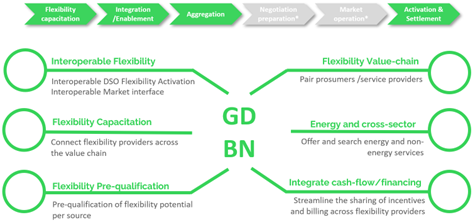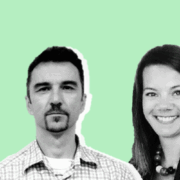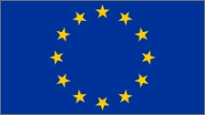Article by Stephane Dotto, from SAP and Branislav Brbaklic & María Ruiz, from Schneider Electric.
The aim of BeFlexible project is to increase the flexibility of energy systems by developing a better coordination between Transmission System Operators (TSOs) and Distribution System Operators (DSOs) and by facilitating the involvement of all energy actors. To accelerate the digital transformation of energy system this initiative focuses on validating and demonstrating proven and adaptable cross-sector services on a large scale. Central to this effort is the developing of an interoperable digital platform designed to support the efficient operation of smart grids.
This platform, known as the Grid Data and Business Network (GDBN) s serves as a foundational enabler for stakeholder collaboration across the flexibility value chain. GDBN facilitates the seamless enrolment and active engagement of diverse flexibility stakeholders—regardless of their role or the scale of their flexibility potential—by providing a unified, interoperable environment for data exchange, coordination, and service integration.
Managing grid congestion with flexibility
The ongoing energy transition introduces numerous challenges to the European energy system, particularly for DSOs. One of the most pressing challenges is managing the increased power volatility driven by the integration of more renewable energy sources and the electrification of energy within the distribution grid. These trends, while essential for decarbonization, introduce significant operational complexity.
As Distributed Energy Resources (DER) become more prevalent and energy consumption patterns evolve, the risk of network congestion increases, particularly on infrastructure not originally designed for such dynamic and decentralized energy flows. This congestion can compromise grid reliability and limit renewable integration. To address this, DSOs must develop innovative strategies and digital tools that enable real-time visibility, flexibility management, and proactive grid planning.
Ensuring a stable and reliable energy supply in this new landscape requires a shift toward data-driven, interoperable solutions that support both operational efficiency and stakeholder coordination.
Flexibility is key to addressing these challenges. It helps balance supply and demand, mitigates congestion, and reduces peak load stress. This capability is particularly crucial for the effective integration of renewable energy sources, thereby increasing the utilization of solar and wind power.
Beyond operational benefits, flexibility can optimize investment in grid infrastructure by reducing the need for costly network reinforcements. It also enhances system stability and reliability by responding to fluctuations in energy generation and consumption. Ultimately, flexibility is a key enabler of decarbonization. It facilitates the integration of high levels of renewable energy and supports the electrification of transport, heating and industry.
Leveraging flexibility makes energy systems more adaptable, resilient, and efficient, contributing to a sustainable and secure energy future.
Integrating EcoStruxure DERMS with GDBN for smarter grid management
BeFlexible’s task 3.4 “ADMS/DERMS for grid-centric services” demonstrates grid-centric services by integrating Schneider Electric’s commercial cloud-based solution, EcoStruxure DERMS, with the project’s GDBN. This integration leverages SAP integration suite to orchestrated flexibility-related messages. The demonstration showcases how advanced distribution management systems (ADMS) and Distributed Energy Resource Management System (DERMS) platforms can interoperate with emerging digital infrastructures to support scalable, interoperable, and automated flexibility services.
The outcome of task 3.4 is developing a flexible, cloud-based (or hybrid) solution designed to support DSOs of all sizes—no matter their level of digital maturity. Built with interoperability in mind, the solution integrates seamlessly with existing systems and platforms, including the project’s own GDBN, making it a scalable and future-ready tool for grid management.
The architecture comprises multiple interconnected components that collaborate to manage flexibility and optimize the DSO grid. The architecture leverages SAP’s Business Technology Platform (BTP), which provides externalized computing resources in the form of a Kubernetes cluster. The GDBN is deployed as a container within this cluster, utilizing SAP’s Integration Suite.
The Integration Suite plays a central role in enabling seamless interoperability between internal and external systems within the BeFlexible architecture. It not only orchestrates various SAP services that interface with the GDBN to manage asset repositories and energy measurements but also facilitates integration with external platforms, such as Schneider’s DERMS. This integration ensures the efficient exchange of flexibility-related messages, supporting coordinated grid operations and enabling scalable, modular deployment of flexibility services across diverse system environments.

Figure 1 – EcoStruxure DERMS integration with GDBN schema.
The Grid Data and Business Network (GDBN): a digital hub for grid flexibility
The GDBN platform serves as foundational digital ecosystem designed to support all key activities across the flexibility value chain. It provides an integrated environment for a wide range of stakeholders—including consumers, service providers, aggregators, and DSOs—to identify, unlock, and utilize available flexibility potential. As a multi-stakeholder platform, it offers distinct value propositions for each stakeholder.

Figure 2 – Value chain stages supported by the GDBN and main functionalities of this digital platform.
By joining the relevant stakeholders in one common platform, the GDBN provides a repository of relevant data across the flexibility value-chain. It makes installed (used and unused) data from consumers available to service providers, contributing to planning process of flexibility provision.
Main achievements: transforming the future of energy with BeFlexible
The BeFlexible project has made substantial progress in developing solutions to enhance grid flexibility and integration, particularly through digital innovation and interoperability. Below are the key achievements, showcasing how the project has advanced flexibility management, platform integration, and system optimization across Europe’s energy landscape.
- GDBN Platform Development:
- Creation of a comprehensive, cloud-based digital platform hosted on SAP’s BTP enabling scalability.
- Supports the entire flexibility value chain, including provision, aggregation, activation, and settlement.
- Features a user-friendly web-based interface for seamless stakeholder interactions.
- Stakeholder Integration and Value Propositions:
- Offers tailored value propositions for diverse stakeholders (consumers, service providers, aggregators, DSOs).
- Facilitates identification and utilization of flexibility potential across the energy ecosystem.
- Enables new business models aligned with consumer needs and regulatory frameworks.
- Flexibility Provision Protocol:
- Defines standardized protocols for flexibility provision, enhancing interoperability among different systems.
- Streamlines communication between flexibility providers, aggregators, and system operators.
- Technical Implementation and Integration:
- Leverages SAP services for asset management (SAP Measurement Concept Management) and energy data storage (SAP Cloud for Energy).
- Integrates Schneider Electric’s EcoStruxure DERMS platform for advanced grid-centric services.
- Implements robust data management practices and leverage SAP’s secure cloud infrastructure to maintain data integrity and confidentiality.
- Designed with modular architecture to allow for future expansion and adaptations.
- Distributed Energy Resource Management System:
- Calculates network transport capacity, down to individual customer level.
- Forecasts grid congestion using DERMS forecast module.
- Determines flexibility needs Based on available flexibility received from FSP.
- Issues dispatch command to FSPs to mitigate congestion.
Looking ahead: towards a decarbonized and resilient energy system
The BeFlexible project demonstrates how digital innovation, interoperability, and stakeholder collaboration can unlock the full potential of flexibility in modern power systems. By integrating platforms like GDBN with advanced solutions such as Schneider Electric’s EcoStruxure DERMS and SAP technologies, the project delivers a scalable, modular, and secure architecture tailored to the evolving needs of DSOs. These achievements lay a strong foundation for a more resilient, efficient, and decarbonized energy future across Europe.
Stay tuned with BeFlexible by following us on LinkedIn and X!




